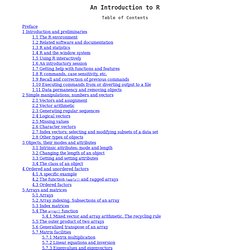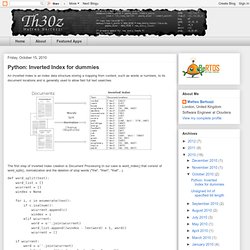

An Introduction to R. Table of Contents This is an introduction to R (“GNU S”), a language and environment for statistical computing and graphics.

R is similar to the award-winning1 S system, which was developed at Bell Laboratories by John Chambers et al. It provides a wide variety of statistical and graphical techniques (linear and nonlinear modelling, statistical tests, time series analysis, classification, clustering, ...). This manual provides information on data types, programming elements, statistical modelling and graphics.
This manual is for R, version 3.1.0 (2014-04-10). Copyright © 1990 W. Permission is granted to make and distribute verbatim copies of this manual provided the copyright notice and this permission notice are preserved on all copies. Preface This introduction to R is derived from an original set of notes describing the S and S-PLUS environments written in 1990–2 by Bill Venables and David M.
Comments and corrections are always welcome. Suggestions to the reader 1.1 The R environment Try ? How to Prioritize Work: 7 Practical Methods for When "Everything is Important" One of the biggest struggles in the modern workplace is knowing how to prioritize work.

Workloads are ballooning and everything feels important. However, the truth is that a lot of the work we do every day doesn’t really need to be done. At least not right away. Learning how to prioritize means getting more out of the limited time you have each day. It’s one of the cornerstones of productivity and once you know how to properly prioritize, it can help with everything from your time management to work life balance. But while the elements of prioritization are simple (i.e. To make things easier, we’ve collected some of the best strategies out there on how to prioritize work into one master list. RescueTime tells you exactly how you’re spending your time every day so you can prioritize the work that matters most. 1. Prioritization happens on different levels.
Unfortunately, those lists don’t always match up. However, when setting your priorities, try not to get too “task oriented”. OpenStack.
Python Language. Python: Inverted Index for dummies. An Inverted Index is an index data structure storing a mapping from content, such as words or numbers, to its document locations and is generally used to allow fast full text searches.

The first step of Inverted Index creation is Document Processing In our case is word_index() that consist of word_split(), normalization and the deletion of stop words ("the", "then", "that"...). def word_split(text): word_list = [] wcurrent = [] windex = None for i, c in enumerate(text): if c.isalnum(): wcurrent.append(c) windex = i elif wcurrent: word = u''.join(wcurrent) word_list.append((windex - len(word) + 1, word)) wcurrent = [] if wcurrent: word = u''.join(wcurrent) word_list.append((windex - len(word) + 1, word)) return word_list word_split() is quite a long function that does a really simple job split words.
You can rewrite it with just one line using something like re.split('\W+', text). Cleanup and Normalize are just to function filters to apply after word_split(). Git clone. Python. Phyton&linked. Book - Natural Language Toolkit. Learn Python The Hard Way, 2nd Edition — Learn Python The Hard Way, 2nd Edition.
Просмотр темы - Почему стек. Автор: mOlegДата публикации: 2009.05.21 публикуется впервые Почему стек Введение Почему-то есть люди, считающие, что "обратная запись", используемая в Форте является причиной использования стеков, а не наоборот.

Для того, чтобы разобраться почему удобно использовать стек, и какие преимущества от его использования (а так же недостатки) возникают необходимо немножечко разобраться с тем, как работают вычислительные машины, какие проблемы возникаюти при их реализации, какие другие варианты кроме стека существуют. Любой алгоритм можно выполнить, используя всего четыре регистра: 2 регистра данных: ra и rb , указатель на выполняемую команду ip, и флаговый регистр f. Регистры ra, rb, ip могут получать данные из памяти, а так же, скорее всего, пересылать данные между собой. О "четверках" Собственно, одна из методик преобразования кода основана на генерации, так называемых, «четверок»(tuples), которые, по сути, и отражают «базовую архитектуру» описанную выше.
Проблемы базовой архитектуры. Prog. OpenStack Open Source Cloud Computing Software. Software.